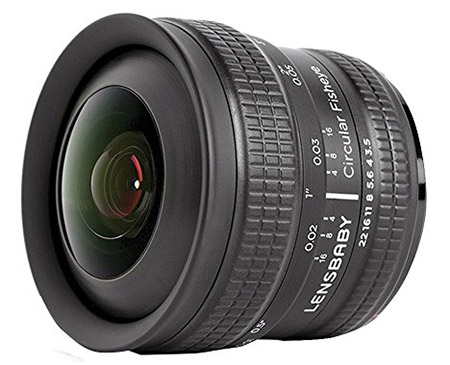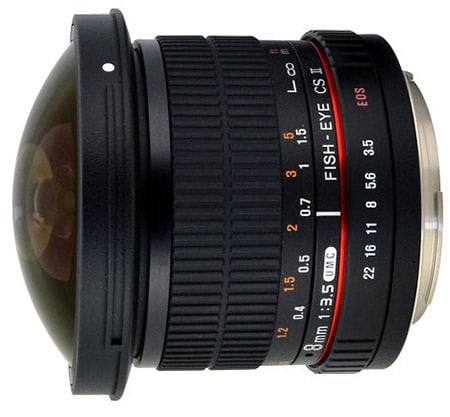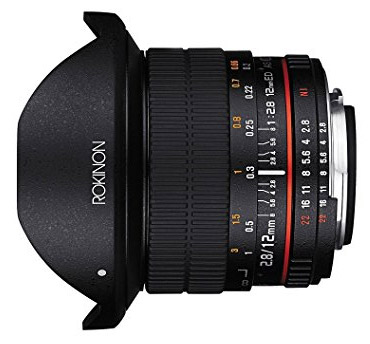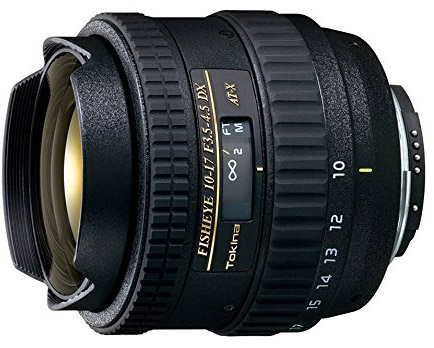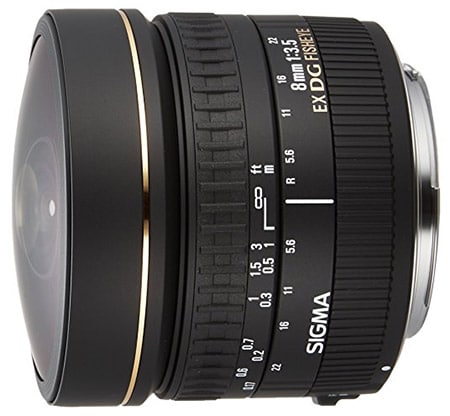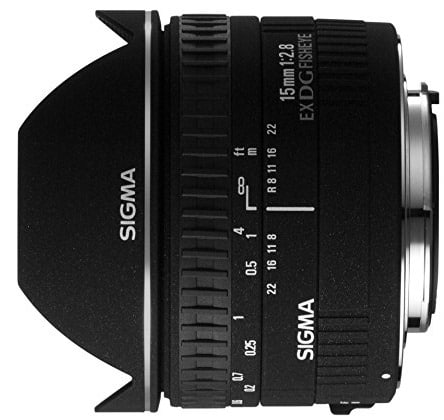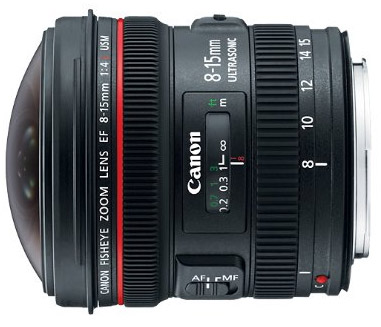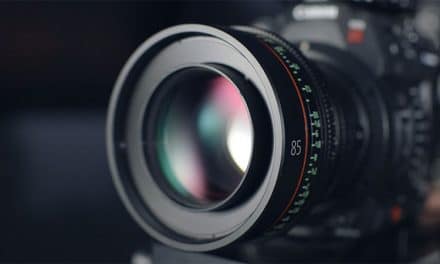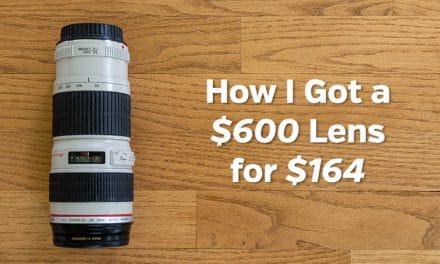While wide-angle lenses are a staple of landscape photography, the wide-angle fisheye lens can offer the same expansive views and perspectives, but with a unique twist. The distortion created by a fisheye lens can present a fun change of pace that you might enjoy.
A fisheye is probably not a lens that you will use as often as some of your other lenses, but in the right situation, it can be very useful.
On this page, we’ll take a look at some of the best fisheye lenses that are available for Canon users. Fortunately, fisheye lenses are quite affordable and you can get a decent lens without breaking the bank.
Also, they are very small and lightweight, so they won’t add too much bulk to your camera bag or backpack.
Before we take a look at the specific lenses on this list it is important to understand the differences between fisheye lenses. You’ll see some described as “circular” and others described as “diagonal”. It is very important to understand the difference and know what you want because the images will look completely different.
A circular fisheye lens will produce a circular image in the center with black edges around it, like the image shown below.
A diagonal fisheye, on the other hand, will cover the entire frame of the image. With the diagonal fisheye, you don’t get that circular effect, but you do get significant distortion, especially at the edges.
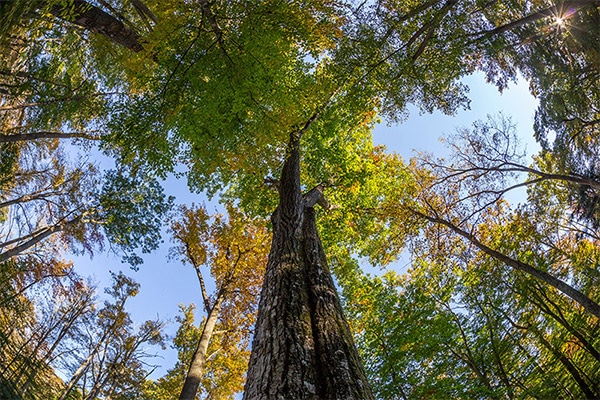
Photo by Marc Andre
The type of effect that you want will have a big impact on the lens that you choose (our top-rated lens is capable of both circular and diagonal effects on full-frame sensors).
You may be interested in other articles in this series:
- Reviews of the Best Wide Angle Lenses for Canon DSLRs
- Reviews of the Best Standard Zoom Lenses for Canon DSLRs
- Reviews of the Best Telephoto Lenses for Canon DSLRs
- Reviews of the Best Macro Lenses for Canon DSLRs
- The Best Lenses for Landscape Photography
What Exactly Is A Fisheye Lens?
A fisheye lens is a type of prime lens, meaning that it is not able to zoom in or out. These lenses are also known as “ultra-wide-angle” lenses. The design of a fisheye lens allows it to take in an extremely wide-angle, and provide you with a huge field of view.
If you’ve ever lived in an apartment building or owned a home with a “peephole,” you’re probably already familiar with how a fisheye lens looks. It distorts the image and curves it, but provides you with a wide field of view – allowing you to see the entire area outside your door.
The term “fisheye lens” was introduced in 1906, and fisheye lenses were first used professionally in the 1920s to study cloud formations, and take whole-sky photographs, hence the alternative nickname “whole-sky lenses.”
The angle of view of a fisheye lens usually ranges from about 100-180 degrees, depending on the lens. The focal length for most full-frame fisheye lenses is about 8 millimeters.
In contrast, a traditional “wide-angle” lens usually has an angle of view of between 64° and 84. Thanks to the curved, distorted image a fisheye lens provides, it can more than double this measurement – allowing you to capture more of your surroundings, albeit in a distorted manner.
The Surprising Power and Versatility Of The Fisheye Lens
Among professional landscape photographers – and professional photographers of many kinds – fisheye lenses are widely considered to be a gimmick. Many photographers think that, due to the distortion and surrealistic effects of a fisheye lens, these lenses do not lend themselves well to landscape photography.
We certainly are not going to tell you that you should purchase a high-quality fisheye lens when you’re just starting out as a photographer. You’ll be much better off building up a collection of lenses that includes a telephoto, wide-angle, and other such lenses – at least, when you’re a beginner.
However, fisheye lenses offer unique creative possibilities that cannot be offered by any other type of lens. And while photo editing can be used for “fisheye” effects, it’s never quite the same.
If you are a more experienced photographer, We really do believe that you can use a fisheye lens. Using a fisheye lens, you can take some really interesting and unique photos. So, in this article, we’ll explore the basics about fisheye lenses, some of the reasons we think they’re so cool, and a few tips that will help you use a fisheye lens in your photography.
Read on, and learn more.
Why Should I Get A Fisheye Lens?
So, a fisheye lens allows you to get an enormous field of view, and introduce some unique distortion and curves that you can’t get with any other lens. Pretty cool, right? Not convinced that you should get a fisheye lens? Here are a few reasons that a fisheye lens is a good addition to your gear bag.
- They’re great for astrophotography– If you want to take photos of the night sky and get as much of the sky in your photograph as possible, a fisheye lens is definitely the right choice. When shooting the sky, the effects of distortion are minimal – and can also be used for artistic effects.
Using a fisheye lens, you can capture more stars than you would ever be able to with a traditional wide-angle lens. You can also distort the landscape and the horizon, which can provide some truly gorgeous, surreal effects thanks to the ghostly beauty of the night sky.
- You can take stunning photos from great heights– A fisheye lens is a great way to introduce a feeling of “vertigo” when shooting from high places like cliffs, mountains, or even tall buildings if you like taking cityscapes. You can distort the view, get close to the ground and include it in the shot – the opportunities are limitless, and you can get extremely creative with your fisheye lens.
- Distortion can work to your advantage– Distortion is not always a bad thing. You can use distortion to create compositions that would not be possible with other types of lenses. Imagine that you’re in California in the Redwood National Park, and you’re surrounded by redwoods that are reaching into the sky, towering over you. A fisheye lens is a great way to capture the true beauty and majesty of these trees – you can lie back, take a shot, and watch the trees bending and soaring into the sky! By playing with distortion, you can add unique effects and atmosphere to your photos that may otherwise be impossible to capture.
- You can experiment with perspective– A fisheye lens truly changes how you see your photographs. This can’t be said for any other type of lens, at least not to the same extent as a fisheye lens. You can’t zoom with a fisheye lens, but you can still play with perspective in a lot of other ways.
Try taking some shots from low to the ground, pointing upward. Get close to your subject – then back away. Try shooting with weird angles. The angle and distance to your subject will change how the lens distorts the image – allowing you to get a ton of totally unique photos and shots.
Have we convinced you yet? we hope so. A fisheye lens is a great way to open up more creative possibilities if you’re an amateur photographer and can help you get a new perspective on your favorite subjects.
Our Tips For Shooting With A Fisheye Lens
Convinced that you need a fisheye lens? Great! Need some tips for shooting? Here are a few of our top pieces of advice.
- Play with the center of your image– The center of your image will typically be the least-distorted, so play around with how you’re centering your lens. If you want a very dramatic distortive effect, keep the center of your image away from the horizon. Conversely, if you want to minimize distortion, keep your image centered on the horizon or your subject.
- Don’t be afraid to experiment– It will take some time before you understand the creative possibilities of a fisheye lens. So go nuts! Take as many photos as you want, and try to be as creative as you can. Experimentation is the best way to get a feel for your new lens and start taking better photos.
- Look for natural curves– If you take photos of an object with a lot of natural curves, the distortion of a fisheye lens will add another layer of surreal effects to it, and create some truly incredible compositions.
- Look for straight lines and angles– You don’t need to just shoot curves. Using a fisheye lens to bend and distort straight lines – such as skyscrapers towering over your city – can also create unique effects.
- Don’t be afraid to edit– Some photo processing software can smooth out some of the distortions of a fisheye lens. Once you’ve taken some great shots, play around with Lightroom, Photoshop or your favorite photo editing software, and see what kinds of cool effects you can achieve by using these tools.
- Consider renting or borrowing a fisheye lens first– If you’ve never used a fisheye lens, we would recommend that you try renting a fisheye lens before you buy one. Fisheye lenses usually start at around $200-$300, so they won’t break the bank – unlike some zoom and telephoto lenses.
However, we will admit that fisheye photography is not for everyone. Because of that, it may be wise to rent or borrow a fisheye lens and try it out for yourself before you buy one.
The Best Fisheye Lenses for Canon
7. Lensbaby 5.8mm f/3.5 Circular Fisheye Lens
This fisheye lens from Lensbaby uses a wide 5.8mm focal length and creates a circular image. The lens is most ideal for APS-C sensors. The lens will create a circular image with either APS-C or full-frame sensors, but with full-frame sensors, the image will be smaller in the center of the frame. This is a manual focus only lens.
It is priced very low and a good entry-level option, especially if you are using a camera with an APS-C sensor.
- For full frame or APS-C sensors
- focal range: 5.8mm
- aperture range: f/3.5 – f/22
- image stabilization: no
- autofocus: no
- weight: 10.5 oz.
6. Rokinon 8mm f/3.5 HD Fisheye Lens
The Rokinon 8mm fisheye will create a circular image on full-frame cameras but gives a 167-degree diagonal field of view on APS-C sensors. The lens hood can be removed (if you’re using a full-frame camera the lens hood can interfere). Like the Lensbaby 5.8mm, this is a manual focus only lens, and the aperture ranges from f/3.5 to f/22.
This is an extremely affordable lens that is capable of quality images. It is a good buy for the money.
- For full frame or APS-C sensors
- focal range: 8mm
- aperture range: f/3.5 – f/22
- image stabilization: no
- autofocus: no
- weight: 15 oz.
5. Rokinon 12mm f/2.8 ED AS IF NCS UMC Fisheye Lens
The Rokinon 12mm fisheye lens produces a 180-degree rectangular angle of view on full-frame sensors, and can also be used with APS-C sensors. Like the others mentioned so far, this lens is manual focus only.
Although this one steps up a bit in price compared to the 8mm Rokinon fisheye lens, it is still a very affordable lens and a great value.
- For full frame or APS-C sensors
- focal range: 12mm
- aperture range: f/2.8 – f/22
- image stabilization: no
- autofocus: no
- weight: 18 oz.
4. Tokina 10-17mm f/3.5-4.5 AT-X 107 AF DX Fisheye Lens
The Tokina 10-17mm fisheye lens is only for APS-C sensors. It provides a 180-degree diagonal field of view. It is the first lens on our list that has zoom capabilities, and also the first with autofocus. This lens is priced a good bit higher than the lenses we have ranked #5 – #7, but it is still priced pretty well.
The autofocus and zoom make it an attractive option if you are using an APS-C camera.
- For APS-C sensors
- focal range: 10-17mm
- aperture range: f/3.5 – f/22
- image stabilization: no
- autofocus: yes
- weight: 12.3 oz.
3. Sigma 8mm f/3.5 EX DG Circular Fisheye Lens
The Sigma 8mm fisheye lens was designed to create a circular image with a 180-degree angle of view for full-frame sensors. With an APS-C sensor, the edges will be cut off, so it does not have a circular effect. This lens does have autofocus and is a quality lens that is capable of excellent images.
It is one of the more expensive lenses on this list, but a good option if it fits within your budget.
- For full frame or APS-C sensors
- focal range: 8mm
- aperture range: f/3.5 – f/22
- image stabilization: no
- autofocus: yes
- weight: 14 oz.
2. Sigma 15mm f/2.8 EX DG Diagonal Fisheye Lens
Unlike the Sigma 8mm fisheye lens, this Sigma 15mm fisheye is designed to create a diagonal distorted effect on full-frame cameras, rather than a circular effect. It offers a 180-degree angle of view. It also offers autofocus and is reasonably priced.
If you’re looking for a diagonal fisheye with autofocus, this lens offers a very good combination of quality and value.
- For full frame or APS-C sensors
- focal range: 15mm
- aperture range: f/2.8– f/22
- image stabilization: no
- autofocus: yes
- weight: 13 oz.
1. Canon EF 8-15mm f/4L Fisheye USM Lens
That brings us to our top-rated fisheye lens, the Canon EF 8-15mm f/4L. This is an excellent quality lens, as you would expect from an L series lens, and it is also the most expensive lens on our list. It is one of only two lenses on our list that offers zoom, and the only one that does so for full-frame sensors. This lens produces a diagonal fisheye image for APS-C sensors. With full-frame sensors, you’ll get a diagonal fisheye effect at 15mm, and a circular fisheye effect at 8mm.
With a 180 degree angle of view, this lens is as good as it gets for fisheye effects.
- For full frame or APS-C sensors
- focal range:8-15mm
- aperture range: f/4– f/22
- image stabilization: no
- autofocus: yes
- weight: 1.2 pounds
How to Choose the Right Fisheye Lens for You?
There are a few factors that you will want to consider when choosing a fisheye lens. First, the budget is always something you will need to think about. The lenses featured on this page start at just a few hundred dollars, so it is possible to get a good fisheye lens without spending a lot.
But some of our higher-ranked lenses do step up in price a good bit. For landscape photographers, we recommend that you prioritize a wide-angle lens, standard zoom lens, and telephoto zoom lens over a fisheye lens. A fisheye is a fun lens to have, but most landscape and nature photographers will not use it as often as the wide-angle, standard zoom, or telephoto.
For that reason, make sure that you allocate your budget accordingly.
Next, it’s very important to decide if you prefer a circular or diagonal fisheye. Make this decision and you can cut the choices in half.
It’s also good to consider if autofocus is important to you. If you are ok with manual focus, the lenses we have ranked #5 – #7 are all pretty good quality lenses at very low prices. If you need autofocus you will need to be willing to up the budget.
A fisheye lens is not right for everyone – and it’s not right for every subject. However, having a fisheye lens in your bag will open up more creative possibilities, which is always a good thing. They’re inexpensive, and experimenting with them can be a lot of.
Ready to get started? Pick up a fisheye lens today, start shooting, and unlock even more creative possibilities! we guarantee you won’t regret it, and you’re sure to get some absolutely spectacular shots whether you love landscapes, nature photography, or cityscapes.
Are you a Nikon user? See our Reviews of the Best Fisheye Lenses for Nikon DSLRs.
Photo license links: Unsplash, Shuttershock








